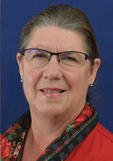DEPARTMENTS
2018 AIHA ELECTIONS
Director (Two to be elected)

Pamela A. Kostle, MS, CIH, FAIHA
Industrial Hygiene Program Manager
University of Wisconsin Madison,
Environmental & Occupational Health
Madison, Wisc.
AIHA professionals are engaged daily in preventing occupational illness and injury and will continue to do so. Many professionals become focused on tasks that are urgent rather than considering how to have a broader impact. The reasons are varied including lack of time, lack of resources, and reluctance to move outside our comfort zone to engage in professional and volunteer activities that raise awareness and engagement in discussions that can lead to eradication of diseases. AIHA’s vision to eliminate workplace illness requires perseverance to ensure conversations necessary to bring attention and action toward eradication are occurring. Evidence of the impact of campaigns and educational materials is supported by the Teen Workplace Safety Task Force’s recent successes. AIHA can facilitate further action toward elimination of workplace illness by strengthening synergies with other organizations and development of resources for IH professionals in a focused and strategic manner. Making the world a better place is a priority of 64 percent of millennials according to an Intelligence Group report. We should consider tapping this talent, capability, and vision, perhaps by mapping outreach resource development that is specific to each IH professional pathway. AIHA and IH professionals must be resilient and continue to persevere in communicating the vision to eliminate workplace illness as did Alice Hamilton, Jonas Salk, and many others in our professional history.
Michael Ochs, MPA, CIH, CSP
Assistant Director,
Environmental Health and Safety
Arizona State University
Tempe, Ariz.
Working together with industry leaders, medical professionals, and university researchers can develop new methods and technologies to eradicate diseases. This activity will advance research and publications on hazardous material substitutions and engineering controls to isolate exposures away from employees. AIHA can promote thought-provoking conversation ideas regarding eradicating diseases through media to encourage this activity.
The future of IH will be confronted with development of new technologies, devices, and materials to both assist them as well as expose new workplace hazards. Industrial hygienists will have advanced sensors available for providing increased accurate and precise real-time monitoring along with faster laboratory analysis. Devices will continue to reduce in size, offer longer operating life, and provide advance warnings of potential exposures to avoid workplace diseases.
AIHA can foster a multifaceted approach to generating national conversations. AIHA must continue to promote conversations among Washington D.C. representatives as well as provide the updates on state and local level to AIHA members. Provide university STEM-minded students and faculty current and practical health and safety educational materials encouraging workplace safety topic discussions and the pursuit of IH careers. Advance the AIHA image and membership through innovative safety campaigns such as #IAmIH. These campaigns reach audiences and media nationwide by AIHA members passing forward their invaluable knowledge to other professionals and industries.
Tim Paz, CIH
Senior Industrial Hygienist
Architect of the Capitol
Washington, D.C.
A disease eradication initiative, such as ending silicosis, would demand a major national, cross-industry commitment. Members of the scientific community, along with other technical experts from academia and industry, would need the collaboration of elected officials at the highest ranks of the government to champion the cause. When President Kennedy announced the goal of landing a man on the moon within a decade in 1961, he spoke about the “why.” AIHA would also have to clearly communicate the silicosis “why” to all stakeholders to get full support for this new moonshot to eradicate an insidious occupational disease.
AIHA is well positioned to help its members reduce exposures to respirable crystalline silica (RCS) through proper air monitoring and engineering controls. The new OSHA silica rule has provided additional incentive for employers to get on board.
We can connect with people by telling the human stories and making it real: a spouse or son or daughter who watched their loved one suffer and die from silicosis. We can train students before they enter the work force, educate employers and unions about the need for better control measures, and use marketing campaigns to show workers the dangers they face.
If we can put a man on the moon, I submit that collectively we can make a difference—we can end silicosis.
Jacob Persky, MPH, CIH
Principal, Co-founder
RHP Risk Management Inc.
Chicago, Ill.
In 1983 the National Academy of Sciences provided two paradigms to distinguish between the concepts of risk assessment and risk management. The practice of industrial hygiene fits well within the risk assessment paradigm, which involves hazard identification, exposure assessment, and risk characterization. I believe our profession is less comfortable within the risk management paradigm, which includes the elements of "control options," "legal considerations," and "other economic and social factors" to drive risk management decisions. When operating within the risk management paradigm, we reach for the "hierarchy of controls" as an accepted approach for control options. Our toolbox is less developed for the "legal" and "economic/social factors" prongs of the paradigm. I believe this 35-year old paradigm does provide a roadmap for AIHA to help members move "beyond" risk management and play a role in the broad public health model. Expansion of AIHA's Government Relations Action Center is one way to raise regulatory awareness and provide opportunities to exert influence, which elevates the topic of workplace health and safety. As we embrace the concept of Total Worker Health, there is an opportunity to bring attention to the important and altruistic work that we do. IHs are more than collectors of data. We can, and should, do more to shape the discussion around the information we place in front of decision makers.
